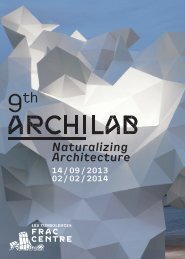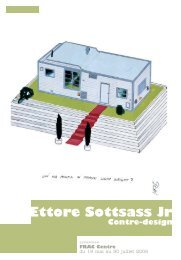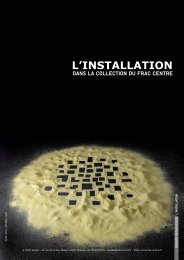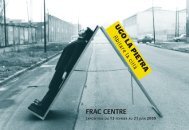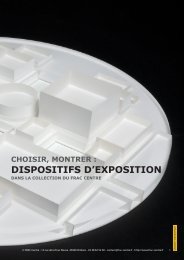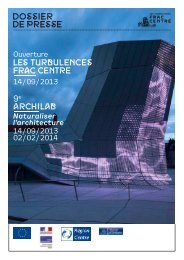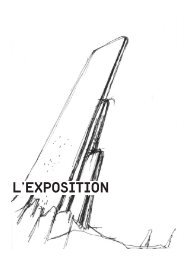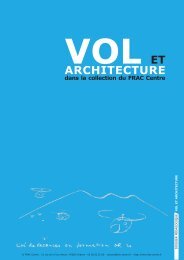Monoliths - FRAC Centre
Monoliths - FRAC Centre
Monoliths - FRAC Centre
You also want an ePaper? Increase the reach of your titles
YUMPU automatically turns print PDFs into web optimized ePapers that Google loves.
Cryptic SpaceThe monolith is the inverted space of the grotto or the cavern, echoing the mythsof origin. The church of Sainte-Bernadette-du-Banlay (1963-66) in Nevers, designedby Claude Parent and Paul Virilio, stands at the point of intersection of the grotto ofBernadette Soubirous, the cryptic nature of the bunker and the spatial dynamic ofthe oblique function. The fault line traversing this fractured monolith seems to be a“negative” kind of architecture, one of refusal (F. Migayrou). Claude Parent’s project ofa Memorial for Yves Klein (1964) also refers to the notion of “crypticity” developed byPaul Virilio. The cryptic space is the negative form of the globe as well, as seen in theconcrete monolith of the Roissy Airport by Paul Andreu (1968).CrystallizationsIn the 1960s, Andrea Branzi drew “Structures liquefying in space,” geometricaggregates that explode into a thousand shards of crystallized monoliths. Geometricspace was being eroded by the irregularity of the monolith. During the same period,the complexity of D.G. Emmerich’s polyhydric forms challenged notions of topologicalspace following the influence of the “utopia of the crystalline” of the 19th and20th centuries. His self-supporting stacks appear as a crystalline agglomeration, amonolith with morphogenetic folds. This crystallization that facets form and makesits anchoring impossible is also seen in sculptures by artist Vincent Mauger.Critical monumentalitiesA recurring feature of post-war architecture, the figure of the monolith is a brutalconcretion of nature and architecture. The monuments to the fallen photographed inthe former Yugoslavia (2007) by artist Jan Kempenaers testify to the monolith’s role ascenotaph.In a conceptual register, DOGMA with Pier Vittorio Aureli examines the notion of theanti-monument, the autonomy of form and context through the Stop-City (2007)project, inspired by Superstudio. Here the monolith delimits a closed and impenetrablespace that places its environment in a state of suspense.Claude ParentMémorial Yves Klein, Saint-Paul-de-Vence,1964-1965Collection <strong>FRAC</strong> <strong>Centre</strong>, OrléansAndrea BranziStructures en liquéfaction, 1968Collection <strong>FRAC</strong> <strong>Centre</strong>, OrléansStanding as a refutation of any formalism, of any aesthetic presupposition, themonolith appears throughout the architectural experimentation of the 20th century.Marie-Ange BrayerDogma(Pier Vittorio Aureli, Martino Tattara)A Simple Heart. Architecture on the Ruins of thePost-fordist City, 2003-2009Collection <strong>FRAC</strong> <strong>Centre</strong>, OrléansAcknowledgments: our thanks to Michel Ragon and Vincent Mauger with Mixar(www.mixar.fr) for the works they have provided on loan.> PRACTICAL INFORMATION :> FREE SHUTTLE BUS from Paris on the day ofthe vernissage: booking with the <strong>FRAC</strong> <strong>Centre</strong>administration required:T. 00 33 (0)2 38 62 52 00@ : contact@frac-centre.fr> <strong>FRAC</strong> <strong>Centre</strong> :<strong>FRAC</strong> <strong>Centre</strong> - 12 rue de la Tour Neuve - OrléansT. 00 33 (0)2 38 62 52 00www.frac-centre.frExhibition from September 17, 2010 to January 30, 2011Entry free of chargeMonday to Friday, from 10 am to 12 pm and from 2pm to 6 pmWeekends and holidays, from 2 pm to 6 pmClosed December 25 and January 1> PRESS CONTACT :<strong>FRAC</strong> <strong>Centre</strong> : Sophie Bellé, Adjointe DiffusionCommunication PressT. 00 33 (0)2 38 68 03 06@ : sophie.belle@frac-centre.frPress photos on requesRegroupement desFonds Régionaux d’ArtContemporain




